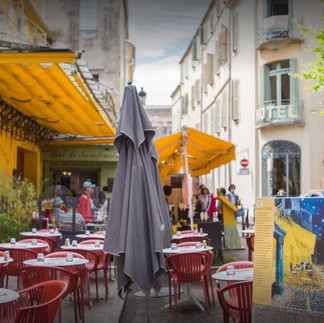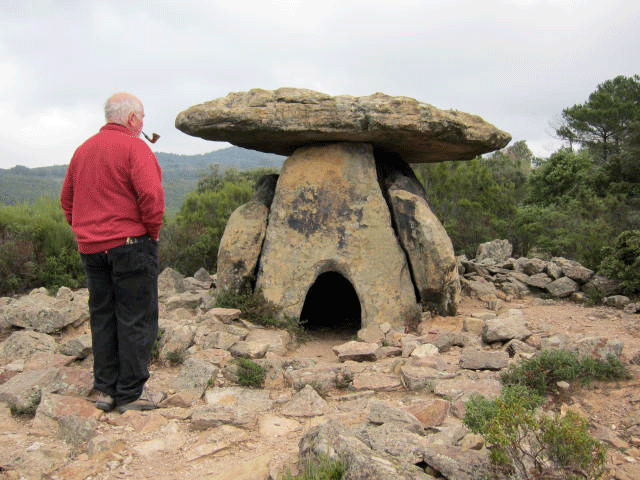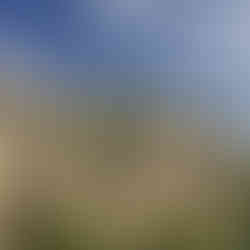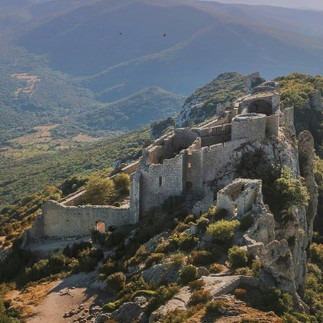Everything is Photogenic and/or Delicious in Southern France!
- Janet STRAYER

- Nov 12, 2022
- 17 min read
Updated: Jul 2
Southern France to the Pyrenees: Languedoc, L'Hérault
Southern France must be one of the most beautiful places to visit on this glorious earth. Good fortune found us living in the region across the years for several months at a time. Other issues of Creative Life News feature a stay in Paris, a drive to Provence and the city of Aix-en-Provence, and residence in Rognes with visits to surrounding spots in this well-favoured region.
In this issue, Creative Life goes to Languedoc, L'Hérault, and other perhaps less well-known sights of southwestern France. We begin our trip in September, after the tourist and summer-season holidays. It truly does seem as if everything is photogenic in the south of France. As an idea of how gorgeous the autumn season can be, look at this house just sitting along a country road. Below it are random photos taken across seasons.

Day-trips or overnight excursions in Southern France let you discover many different worlds. The range of different geographies, micro-climates and opportunities to time-travel is surprising, and the pleasures are enormous. The area of the Midi (a local term for these regions) extends from the Pyrenees bordering Spain, goes eastward along the French Riviera to Italy, and from the Mediterranean goes northward to the French Alps. This is the land of Asterisk and Obelisk, of ancient Ocs, Gauls, Romans, Greeks, of kings, peasants, conquerers, merchants, romance, fables. And of wine and food and art.
What I wish to do here is share some of my impressions of living and travelling a bit across this region, sparking your own impressions, recollections, or new discoveries. My photos are amateur ones, without apology.
What Photography Can and Cannot Capture
What skill is needed to take a scenic photo in southern France? None. Just point and shoot. Believe it. On every walk or outing, there was something lovely to see. Not only the known cultural centers and places cited in travel books, but also the random walks and drives offer some stunning sights. So much to photograph, it's overwhelming. Though it's even better when you have some leisure just to stop, look around, and breathe it all in.
I hate cameras. They are so much more sure than I am about everything. --John Steinbeck
I don't hate cameras, but sometimes I wonder if taking scads of photos is a good idea. Does the quest for the right photo help or perhaps hinder the experience of just looking around? Photos help us remember places, of course. Yet, for me, the search for photo ops can also hinder the natural flow of involvement with the scene and its less panoramic details. I rarely capture in a photo anything like the fullness of what I see or experience. Maybe professional photographers feel differently. For me, having easy access a camera reminds me to keep eyes open and alert. I like that my camera is easy enough to travel with me but small enough to neglect. On the other hand, I look back on some photos I've taken in this region and they seem almost like paintings! The land itself does this.
As a painter, even poor photos help me remember what I thought was worth stopping to see, and sometimes even the feelings that went with it. Given that I have no intention of copying reality in my paintings, what I want from a photo is enough of my experience of that moment to carry with me.
For example, my photos of Lac du Salagou (above) were taken while exploring the Hérault region. More scenic shots could have been taken, but I wanted to remember the redness of the soil against the water, the changing shapes of rocks on the shoreline, and the glassy calm water cradled by soft mountains. That's what I emphasized in a subsequent painting.

Discovering Places
A special feature of thinking like a traveller, instead of like a tourist, is that you keep time to wander, often finding things by chance rather than by destination. Not always headed for a specific "must-see" place, leaves many spots open to exploration of whatever reveals itself. This set of mind puts us into discovery mode, so whatever we happen to find becomes more personal because we've found it ourself (no matter how many other people also may have done so).
If you have the time and good fortune to stay in one place in Southern France for a stretch of time, you can try this out. Look at the names of a few nearby places. Pick one for a day-trip, doesn't matter which one. Go there and explore. You'll find something interesting. I've done that here, and have not yet been disappointed.
Open-Air Markets: Almost Everything is Edible
My fondness for food leads me to enjoy many restaurants of the moderate price category, as well as cafés, little food shops and, of course, the open-air food markets. In a country like France, in which food plays such a distinctive role, I especially love the open-air markets where food, wine, and condiment stalls of all sorts are arranged in tempting displays,. A palette of colours, smells, and tastes invites you to come try a sample. Hard to resist, so why not? There is a market in every town I've visited, some more esteemed than others, but each interesting for its local flavour.
I love these markets because they give access to local tastes and culture, both literally and figuratively in terms of the human interactions witnessed in a brief time. The French residents shopping at local markets seem quite choosy in which stalls to go to for which particular item. They shop with a studied pragmatism that assesses quality and value as they sample goods from one or another vendor.
I get hungry just walking among the different food stalls and my eye is drawn to a particularly colourful display, but my French friend halts, raises her brow, and signals me onward to another place. She knows which vendor in which market has the best olives at the best price, which has the freshest artichokes or fish, which has the best selection of brébis cheese or the best local paté. It must have taken her years to learn this. Of course, I leave the choices to her. It seems to me that every French person I've met, however humble, is a food and wine connoisseur.
Potimarron, shown above, is a delicious local dish my favourite spouse-chef made for us as Halloween approached. He stuffed a red kuri squash (a sweet winter squash with thin, edible skin) with mushrooms, savoury sausage, and chestnuts (or cashews if you prefer), some broth, a little wine, and preferred spices. Our French neighbour had served it to us once and we wanted to recapture the yum of it. I'm sure you can adapt the filling to your tastes: it's a treat to see as well as serve and eat
Lourmarin in Languedoc-Rousillion
Languedoc, just west of Provence, is another beautiful region of grapes, olives, châteaus and lively villages.

Living in nearby Provence, we drove from our village of Rognes to the town of Lourmarin as a weekly event. Its Friday market rivals, on a smaller scale, that of Aix-en-Provence in quality and assortment of goods. Wonderful cheeses (the brébis one with truffles is a fav), wines (any of them!), patés (including duck and sanglier), clothing stalls from shoes to scarves and hats, jewelry, a host of small cafés and easy mingling among visitors and locals. The little town square is a a very popular location, crowded with cafés, restaurants and some art galleries. Among the resident artists, Gerard Isirdi is a popular painter of Lourmarin scenes.
One of Lourmarin's most famous residents was the Nobel-winning author, Albert Camus. More recently m we carry a memento from a contemporary author who also had lived here. Inscribed to us during a previous visit it says, "Come back soon," signed by Peter Mayle, author of bestselling A Year in Provence. We did come back, but it was years later.
Canal du Midi: Water Routes in Languedoc and l'Hérault
A notable feature as we travel southwestward are the prominent canals, both natural and constructed, that link the Atlantic and the Mediterranean (Canal du Midi). This 150 mile water route is one of the great engineering feats enduring from the 17th century.
The region of towns and cities linked by these canals is known informally as le Midi. Below is a typical photo of boats moored beside warehouses en route to Sète, in a town worth a stop for its lively market, fish shops, and many restaurants along the waterline. Houseboats and canal trips seem a pleasant option, especially in good weather. Fish and seafood restaurants are good and abundant, with many local folk as well as visitors enjoying them.


Walking in l'Hérault
One step at a time is good walking. -- Chinese proverb All walking is discovery. On foot we take the time to see things whole. -- Hal Borland, NY Times
All truly great thoughts are conceived by walking. -- Frederich Nietszche
I first came the to the Hérault region as an invalid (an odd word, considering it suggests that one is no longer valid). Several broken vertebrae left me barely able to walk. It was only with the help of my caring spouse that I could start this adventure at all, and I marvel at his capacities.
One capacity, which I endorse wholeheartedly, is the ability to enjoy and live as well as one can under whatever the circumstances. It's not hedonism, but an appreciation of life. In this way, our European adventure helped me literally to make great strides.
We lived in the ancient village of St. Thibéry, beside the Hérault River. The uneven cobblestone streets of this village, charming as they were to look at, were hell for me to walk on. Given that walking freely was a main objective for me to regain, one of my favourite things became taking increasingly longer walks along the nearby path along the banks of the river. The path leads to an ancient mill and the remains of an ancient Roman bridge that still extends nearly across the river.
Hiking and walking are among the best ways to get to see much you might not otherwise chance upon. Even when walking ability is limited, one step at a time can get you to remarkable places. I'll share some of these spots seen while walking to prove it.
Priory Grandmont in l'Hérault
Among the places found by chance while we were en route somewhere else, we found the Priory Saint-Michel de Grandmont. It is an austerely beautiful old monastery, no longer inhabited but in remarkably good shape. Walking around the abbey lets you feel a bit of what it must have been like when inhabited by monks in 1022. It was so COLD inside that I wonder how those barefoot monks centuries ago could have endured it! The exterior is a fine example of Romanesque architecture. How much of what we build now will last as long or attract as much interest? How much of our work is motivated by beauty or reverence for anything beyond function and profit?
I'm partial to the blunt simplicity of Romanesque style vs. Gothic ornateness. I especially like the surprising faces and odd little people carved into the columns and over doors of so many of the medieval structures we saw. I think those below are from St. Maguellone in the Hérault . Such figures are never displayed too prominently, but these "lesser" beings, if you like, are my favourites to seek out.
Valmagne Abbey in l'Hérault
So many interesting cathedrals, churches and related structures are scattered throughout France. I wanted to include the Valmagne Abby (near Mèze ) because it reveals history as you walk through it. Founded in the 12th C, it was constructed as a Cistercian monastery. As it became one of richest abbeys in the region over the next two centuries, you can see how the basic Romanesque architecture became elaborated into ornate Gothic style -- only to be plundered during the Religious Wars, then sacked with all monks expelled during the French Revolution. After that, the Abbey became a huge wine cellar for commercial use, and you see centuries-old huge wooden barrels, larger than a person, tucked into the hollows of its ancient nave. Nearby is the wine-tasting room, with purchases readily available. Quite a place. Not bad wine either.
Medieval Villages Alive and Well
Travelling around this area, you come to appreciate that medieval history lives on. This is seen not only in churches and monasteries but in inhabited villages that originated in medieval times. Residents choose to retain structures, stones, and village design from ancient times. St. Martin de Londres is an example of one such village in the Hérault. Its inhabitants must enjoy the authenticity of their historic homes, though I wouldn't be surprised to find perfectly modern appliances inside.
Arles
You can experience large geographic and scenic differences across relatively small distances in southern France. Arles, for instance, has its own feeling and culture, very different from towns like Lourmarin, which are only about an hour's drive away. Arles has a very strong Roman/Latin influence that you feel as you walk its streets. Its ancient Roman amphitheatre dominates the center of town, still used for bullfights, popular in this area, along with other public events. The town center is filled with trees and good little cafés -- including the one Van Gogh painted with yellow awning against starry blue sky: Café de Nuit (shown in current location, center below).
Arles is known as the French "home" of Van Gogh -- the yellow house with green shutters in his painting (1888). Though he lived here only a year, he produced over 300 drawings and paintings during that time! This is where he immortalized his humble bedroom, as well as memorable paintings of people (Madame Ginoux, shown) and local scenes. It's a special pleasure for any art-lover to walk into the sights and scenes known from paintings! I'm reminded of a wonderfully imaginative film by Kurasawa, Dreams Van Gogh, in which actors enter Van Gogh paintings that come alive.
Bouzigues, Agde, Sète
Beyond the photographed tree, with what to me look like wooden birds in its branches. is the village of Bouzigues, famous for its oysters. My Canadian home on Saturna Island, B.C. also happens to have wonderful oysters. We see them attached to ocean rocks during low tide. Here, IN France, the oysters are in offshore shoals that can be reached by the small boats seen tethered on shore. Eating at one of the beach restaurants in Bouzigues, I was amazed at the huge and artfully arranged platters of oysters and shellfish that came to tables typically seating only two people. I was even more amazed to watch these people consume several dozen of these sexy oysters at a leisurely sitting, leaving only glistening shells to mark their extraordinary culinary prowess.
Nearby is Agde, a port city on the Hérault River linking the Midi Canal and Mediterranean. It's one of the oldest cities in France (along with Marseille and Béziers), first settled by ancient Greeks. Not a major tourist attraction, I enjoyed the easy feel of strolling through Agde on a Sunday. Many families were out, along with the ducks noted in the plaza pond. The beaches at Cap d'Agde are well visited in summer.

Sète, "the Venice" of this region, given its network of canals, seemed a very pleasant and lively city. It's a favourite maritime city for poets (Paul Valéry is buried there) , musicians, and artists. I took endless photos of small, colourful boats along its canal, loved its lively water-side restaurants, and returned often for Sète's good weekly outdoor markets. Nearby are sandy beaches, fairly secluded off-season, and great to walk upon, collecting sea shells.

The Beaches of Southwest France

Ever get bored by walking along the sea? Not me. Anytime, wind, rain, sun, even storm (yes, with good rain-gear on). Some beaches are quite civilized, with promenades built beside them and restaurants skirting the sea. Others are rugged and wide-reaching (like the Pacific northwest shores at home). We found many amiable shoreline beaches along the sweep of the Mediterranean in Southwest France.
The lovely and famous towns along the Côte d'Azure and Riviera to the southeast are justly prized for their magnificent beaches. This section of southwest shoreline differs in its charms. It’s late autumn as I write, so no bikinis or sun-cooked waters. But these Mediterranean beaches are still very inviting. Though some nearby residential areas looked glum without their residents and tourists. They have the look of shuttered down resort villages —still running but at half-throttle, waiting sleepily for their summertime crowds.
Sérignan remains a pretty village, even off-season. It benefits from its natural surroundings and contains some of our favourite beaches, ones that seem to go on forever (below). The sand is soft and golden, settling into dunes. There are many seashells surrounding the tidewaters. You can see one below held up to the light. How special it is to feel the cool breeze while walking along the sea with all the lovely light of this season in the south of France.
Béziers
One of oldest cities in France (along with Marseille), Béziers, in the Hérault region, was founded by ancient Greeks. An urban centre with handsome buildings, Béziers t is surrounded by huge vineyards and agricultural land. The Canal du Midi runs along its south side. Like most cities and villages in France, the local museums are worth visiting, and I found an art supply store I liked in town. Below are some picturesque views of the city seen from the top of St. Nazare Cathedral. PIctures that inspire paintings, no?
Minerve

This medieval village of Minerve in the Hérault balances on a rocky spur above gorges carved into the limestone mountain. You reach it via an impressive viaduct bridge. It's cobble stone streets and now ruined ramparts once welcomed the Cathars in siege against their enemies. Minerve was a relative haven (once you made it inside) for people fleeing persecution because there was no bridge to its fortified structure across a deep gorge. Now, there are said to be only about 100 people who live in houses stacked against the rocks.
A good reason for visiting here is the amazing countryside filled with unusual limestone formations called dolomites. Many of these strange looking rocks are huge, larger than a house.
Dolomites: the Cirque de Merguez
A hike along the Cirque de Merguez will bring you to the scenes you see below. The very rocky limestone terrain, long etched by erosion, has produced some quite marvellous natural sculptures.
Dolmen
Dolmen are fantastic stone structures that look like houses, some aligned like multiple-house dwellings. They are many thousands of years old. Found in several regions of the world (Korea has many, Stonehenge is famous in Britain), in France they are found scattered from Brittany to the Mediterranean coast.
Often marked with fertility symbols, dolmens are now thought to have been ceremonial burial chambers, some tunnelling underground (middle photo below) as well as structured above ground. It's remarkable to think how such massive megaliths were moved to different locations by ancients who also expended major effort to carve one side smooth in order to fit these massive stones together as structures.
Carcassonne and Peyrepertuse
Carcassonne (first photo below) is probably the quintessential French city of castle and fortress. It is a major tourist attraction that comes straight to us from the middle ages, conserved and reconstructed. The town was settled and fought over well before the middle ages, given its strategic position between the Atlantic and Mediterranean. Carcassonne has played a huge role in history, especially notable during the Cathar religious rebellion, as well as other prominent wars and religious feuds.
Being in Carcassonne now feels a bit like you've stepped into a movie. It's every western child's castle fantasy. There are many events and festivals hosted there, including jousts in full regalia, that re-enact history in well-researched costumes. Certainly, it is a tourist attraction. A bit disconcerting to see knights in full regalia from a recent joust, having ice-cream cones at a street-side table. But it's fun. Besides, take a solitary walk around the ramparts and alleys of this city and it's hard to resist time-travelling.
For a stunning shift of pace ( third photo below), about 85 km further south and even closer to the Pyrenees is the Chateau Fortress of Peyrepertuse. It crests a limestone cliff with a magnificent panoramic view. Wear sturdy shoes. This is quite a staggering structure to explore. Walking its ruins provides a more individual imaginative experience of medieval life and struggle, in contrast to Carcassonne.
Further Southwest to the Pyrenees: Toulouse
We didn't have much time in Toulouse, a large and attractive city of gold-pink terracotta bricks. Like many places close to the Spanish border, a Basque/Spanish flavour mingles with the French. Toulouse is officially along the route of the Santiago de Campostela trail going across the Pyrenees. Founded as a city by the Romans, Toulouse was inhabited earlier by Iberians and Gauls, and subsequently had a tumultuous history through the Religious Wars and the Napoleonic era. The Hall of the Illustrious (first photo above) in the City Hall (Capitol) provides an ornate depiction of some of the city's history.
Notable among the city's architectural attractions is the Basilica of Saint-Sernin, one of the largest Romanesque structures in Europe, with beautiful carvings.and sculptures, just one of which I've shown (middle photo above). We had just enough time to visit the Augustine Museum of Fine Arts, set in a former convent. Most of its art and architectural collection ranges from the middle ages to early 20th century. My favourite setting in the museum was the cloisters, where you can see an impressive of array of gargoyles set up as statues (third photo above).
The Camargue-- a Change of Pace
Enter the Camargue and you wonder where you might be. It seems a unique country, not a part of France.

This southwestern region is France's "wild west" and home to the largest area of marshes and wetlands in the country. For centuries, the area has been used to graze cattle, horses, and sheep. Famous semi-wild horses still roam the delta. I managed to see the famous white Camargue horses romping in fenced yards, but my photo from our moving car was too poor (replaced by one from the Camargue National Park).
The land and gardians (cowboys, gauchos, rancheros, vaqueros, charros, etc.) of this region who herd cattle and horses seem to live in a manner apart from the places we've already visited. In contrast to any other "wild west" we might know, the Camargue is uniquely positioned in Europe's largest river delta and, to top it all off, outrageous pink flamingos preen along its salt flats and wetlands.Traditions are different here, with local white-washed huts and homes, ways of dress, dance and guitar music making this region distinctly its own. Seems to me much closer culturally to flamenco Spain than to Paris. The popular music group, the Gypsy Kings, are from this region.
Despite its uniqueness, the Camargue, like the rest of France, justly boasts its local crop of very good wines. And, like much of France, its ancient and medieval towns are so very interesting to visit and explore (like the Romanesque abbey of St. Gilles).
Saintes-Maries-de-la-Mer

Saintes-Maries-de-la-Mer is a small village beside the sea in the Camargue. The town's name refers to multiple Marys: the Virgin Mary, her sister Mary, and Mary Magdalen This picturesque village inspired Van Gogh to create a number of paintings and drawings of the town, its inhabitants, fishing boats, and shoreline changes in light.

This village is also a famed place of pilgrimage to honour Saint Sara, also known as the "Black Madonna". Her statue in the main church is robed with many fabrics, so she may appear differently clothed at various times. Legend has it that this as the place where the Virgin Mary, her sister Mary and their dark-skinned maid, Sara, landed (along with Mary Magdalene, Martha, Lazarus and St. Maximin). One legend has Sara throwing her robe into the sea so that it became a raft guiding others safely to shore. In Roma (Gypsy) tradition, the Black Madonna is honoured for good fortune, fertility, and protection.
Collioure at the Pyrenees

Collioure remains a relatively quiet fishing village in southwestern-most France that borders the sea and scrapes the Pyrenees. It is a spot favoured by Matisse and other painters who loved its seclusion and bluish-light. This is where, in the early 1900's, Matisse and André Derain began the Fauvist art movement, a style emphasizing freedom of depiction based upon strong feeling and intense colours. The town boasts a small Museum of Modern Art that includes works by Picasso, Matisse, Derain, and other Fauvist painters. Walking a planned path above the town, named Le Chemin du Fauvisme, you come to replicas of works Matisse and Derain, placed in the same spots the artists painted them.
Our charming hotel was at one edge of the village, positioned across the bay from 17th C Notre-Dame-des-Anges (formerly a lighthouse). The hotel nestled on several levels of rock, with each room named for a famed artist who had stayed in Collioure. We inhabited the Andres Derain room, but would gladly have stayed in any. Here is where I first tasted Banyuls, that dark rich regional wine (almost like port), so smoothly delicious it can accompany even chocolate.
Dalí House-Museum
A bit more than a stone's throw across the Pyrenees from here and you're in Spain's Catalonia region.. Fauvism switches over to Surrealism as you drive to the Salvador Dalí house-museum in Portlligat. Dalí lived in that house (expanded from its origins as a fisherman's hut) from 1930-1983, and everything in and around it certainly reflects his surreal talent and showmanship: the layout, furniture, paintings, sculptures, clocks and landscaping. It's a blast, but I'll leave more details for a column of Creative Life in Spain.
A Reminder
I'll end this column with very simple photo - taken from the car as we travelled in southern France. It is a simple appreciation for the land one passes, no tourist sites visible, no notable structures or events: just the pleasing beauty that can be found in the remarkably ordinary on a calm day. One of the things travelling also teaches: Appreciate where you are!

I'm interested in your comments for this post -- click to email me your comments















































































































Comments